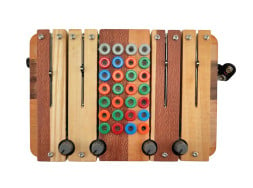Ciat-LonbardeCocoquantus 2 Looping Delay + Synthesizer
-
 Free
Free
Shipping -
 No Hassle
No Hassle
Returns -
 Extended
Extended
Warranty
Ciat-Lonbarde Cocoquantus 2
Challenging the distinction between instrument and effect, Ciat-Lonbarde's Cocoquantus is a dual 8-bit digital delay with a central array of five oscillators pre-disposed to chaotic relationships and complex patching. Well-suited for processing its own sounds or any possible external source, Cocoquantus is a curious workstation for capturing, looping, and otherwise mangling sounds—often in ways that aren't quite comprehensible. However, by allowing yourself to give up some control and treat the instrument more as a collaborator, Cocoquantus can be an incredible musical companion.
The Cocoquantus consists of three primary blocks: the Coco delays (of which there are two), the Quantussy pentagonal oscillator bank, and the left-most input section for microphones and high-impedance sources. These inputs offer their own independent gain controls and produce the amplified signal on the white banana jack and an envelope follower on the orange. In addition to those left inputs, a pair of stereo line-level inputs are also available on the front, routing the left and right signals of each to their respective Coco's input.
The Cocos are always listening to all of their inputs simultaneously: the two minijack inputs on the front, and the bottom green banana jack, with their input level set by the bottom leftmost knob. However, when powering on the Cocoquantus, both Coco delay buffers are filled with random values, producing white noise without the need to patch anything. Whether you'd like to treat this as a noisy bed or replace it entirely with other sources, the Cocoquantus does not feature an instantaneous "clear buffer" function. Instead, when recording is engaged by pressing the button keys in the middle, sounds are iteratively layered or erased according to the position of the Feedback control: the bottom rightmost knob on each Coco.
The Coco delays are highly receptive to modulations, and sport numerous inputs to facilitate this ability. One of the most important controls is the buffer playback speed, which in turn defines the length of loops and delays. The left knob under S sets the base speed, while the purple input allows for speed modulation, for which the amount is set by A. Above these, the yellow jack is actually an audio output: a series of layered square waves derived from the delay clock signal. At the very top, the left green input flips the buffer playback direction while the right skips back to the start—the grey jack in the middle is the Coco output!
One of the more curious aspects of the Cocoquantus are the Dolby switches on each Coco. These effectively allow the input and effect signals to gate or modify the signal level of itself of the other element, depending on the position of the switch. For example, setting the left position up with reduce the level of any material in the buffer while sound is coming in, allowing for new events to stand out. Alongside these, the pairs of blue jacks at the bottom modify the input and effects levels respectively. These jacks, similar to certain other Ciat-Lonbarde instruments, are verso/inverso pairs: signals patched into verso inputs are added to the knob position, whereas signals into inverso, denoted by dots in the wood around the jack, are subtracted from the knob position.
The central Quantussy is the source of the internal audio and modulation signals available to Cocoquantus. Each oscillator is a triangle wave with a three-position frequency range switch, and the five are arranged to allow for numerous different chaotic relationships. You can find each oscillator's triangle output from the orange jack, and patching into another oscillator's blue jack allows for FM relationships. But the most interesting and mysterious voltages are going to be from the grey outputs, which are fed a number of different signals from elsewhere in the Quantussy. Signals patched to the green input step through different possible routings, with their state conveyed by the LEDs in the middle. This is quintessential Ciat-Lonbarde—worry less about what exactly is happening and concern yourself with the spontaneous results to be had by making and removing patch connections.
Cocoquantus has earned its reputation for being one of the most rewarding Ciat-Lonbarde instruments. Its nature as a curious looping delay lends itself well to ambient washes, but its capabilities don't stop there. Should you invite the Cocoquantus into your studio, be prepared to listen and interact with it more as a living thing rather than an instrument.
Cocoquantus 2 Features
- Dual 8-bit delay + chaotic oscillator synthesizer
- Inputs for XLR microphones, high-impedance instrument sources, and two stereo line-level sources
- 8-bit delay/loopers with variable speed controls
- Dolby switches gate input/effect signals
- Dual CV inputs for increasing or decreasing VCA levels
- 5-part chaotic oscillator array
- Global pitch and chaos controls
- Triangle and stepped CV outputs
- Three-position oscillator range switches
- Dimensions: 12.6" x 6.3" x 2" / 320 x 160 x 50 mm
- Power: 12VDC PSU (included), 9V battery
 Chaotic Sound SynthesisBeyond Conventional Synthesis: Worlds Within CocoquantusExploring Ciat-Lonbarde's Chaotic Delay/Sampling EcosystemHello Shnth: A Timbered Enigma in the World of SynthesizersModular Synthesis and Computer Music Encapsulated
Chaotic Sound SynthesisBeyond Conventional Synthesis: Worlds Within CocoquantusExploring Ciat-Lonbarde's Chaotic Delay/Sampling EcosystemHello Shnth: A Timbered Enigma in the World of SynthesizersModular Synthesis and Computer Music Encapsulated






Welcome Back!
Not a member yet?
You're in!
Join the Club!
As a member, get...
You're in the Club!